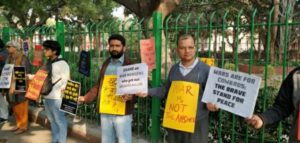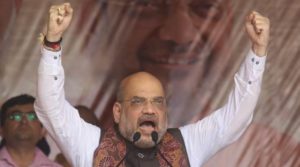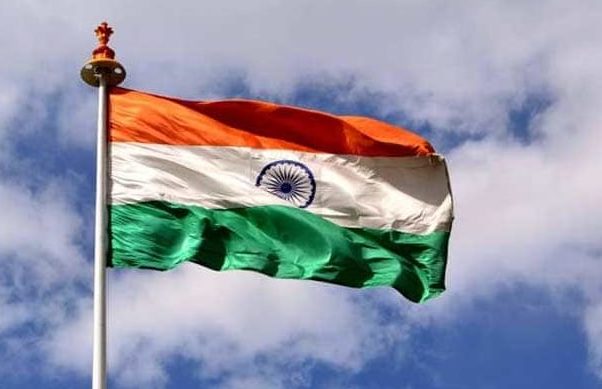When the truth is replaced by silence, the silence is a lie.
— Yevgeny Yevtushenko
I
When I had travelled to Siem Reap in Cambodia for the first time in 2005, I saw the most wondrous of all temples. It was called Preah Khan that means ‘Royal Sword’ or the ‘Temple of Sacred Sword’. It was built in the 12th century by King Jayavarman VII – in the long lineage of Cambodian kings who followed Hinduism and Buddhism.
The presiding deity of the temple was Buddhist deity Avalokiteshvara. The central shrine was a Buddhist Stupa. But four Shiva Lingas were at the four directions from the central stupa, and after that, goddesses of both Hindu and Buddhist origins surrounded the outer walls of the temple.
It was a stunning amalgamation of Buddhism and Hinduism that I hadn’t encountered anywhere else, except for in our national flag, or the Tricolour.
*
The National Flag is a tricolour of saffron, white and green; with the Ashoka Chakra, a 24-spoke wheel, in navy blue at its centre.
Sarvepalli Radhakrishnan – the scholar of Indian philosophy, who wrote a classic two-volume Indian Philosophy, and later became the second President of India – had clarified the meaning of the Tricolour when it was adopted on 22 July 1947:
‘Bhagwa or the saffron colour denotes renunciation or disinterestedness. Our leaders must be indifferent to material gains and dedicate themselves to their work. The white in the centre is light, the path of truth to guide our conduct. The green shows our relation to (the) soil, our relation to the plant life here, on which all other life depends. The Ashoka Chakra in the centre of the white is the wheel of the law of dharma. Truth or satya, dharma or virtue ought to be the controlling principle of those who work under this flag. Again, the wheel denotes motion. There is death in stagnation. There is life in movement. India should no more resist change, it must move and go forward. The wheel represents the dynamism of a peaceful change.’
The emblem of the Chakra or The Wheel with 24 spokes in our Indian flag is borrowed from Ashoka (304-232 BCE); and Ashoka had borrowed the idea from Sakyamuni Buddha’s Dharmachakra or The Wheel of Truth that has a more complex philosophy of Dependent Origination / Conditional Arising behind it, that I am not discussing here.
*
The 24 spokes of the Dharmachakra depicted in the Indian Flag is also considered as symbolic of the 24 Rishis or sages – each representing the 24 syllables of The Gayatri Mantra.
Om bhūr bhuvaḥ svaḥ
tát savitúr váren(i)yaṃ
bhárgo devásya dhīmahi
dhíyo yó naḥ prachodayāt
The Gayatri meter specifies three padas of eight syllables; total of 24 syllables.
The Gayatri Mantra appears in the hymn of Rig Veda 3.62.10, and is preceded by Om.
Sarvepalli Radhakrishnan updated his earlier interpretation of the Gayatri Mantra (of 1947) in 1953:
‘We meditate on the adorable glory of the radiant sun; may he inspire our intelligence.’
This has become the most commonly accepted translation of the hymn.
*
The 24 spokes of the Ashoka Chakra also denote the 24 values described by Sakyamuni Buddha – which all have 24 Sanskrit words (which I am not writing) which mean: Love, Courage, Patience, Peace, Magnanimity, Goodness, Faith, Gentleness, Selflessness, Self-Control, Self-Sacrifice, Truthfulness, Righteousness, Justice, Mercy, Gracefulness, Humility, Loyalty, Sympathy, Spiritual Knowledge, Forgiveness, Honesty, Hope and Eternity.
These 24 values are deemed as the qualities to aspire for by all Indians. They are free of religious connotations – they stem from the wisdom of the human soul – derived through penance and search; they are universal, humane and secular.
India is a young nation state but an old civilisation. This makes India a civilisation state whose desired ideals/values has also been set – along with the Constitution – by the 24 symbolic spokes of Ashoka Chakra in the Indian Flag. This has been done through a spiritual thread that connects the four: the Rishis, Ashoka, Sakyamuni Buddha and the Gayatri Mantra.
II
In the ‘post-Pulwama-Balakot and pre-election’ India, going by the media hysteria, social media frenzy, WhatsApp forwards and political rhetoric, one would perhaps feel that the profound Ashoka Chakra in the Tricolour has been replaced by an Israeli SPICE bomb!
This is not an absurd notion in our world: the flag of Mozambique includes the image of an AK 47 with a bayonet.
Even if the spokesperson of the Government spoke about ‘non-military pre-emptive strike’ in reference to Balakot, the warmongering anchors of the Godi Media was spinning the fight against terrorism by equating it – openly and in coded language, while keeping an eye on the coming elections – with the fight against Pakistan, Muslims, the Opposition and #SayNoToWar brigade.

Even when foreign media was running humiliating headlines such as ‘Satellite Images Suggest India Fabricated “Successful” Attack on Terror Camp’ (Zerohedge) the BJP President Amit Shah, and ‘official sources’, were still claiming a body count of 250-350 fidayeens.
Then the absurd conflation of asking legitimate questions to the Government with distrusting the Indian Air Force, and taking the side of Pakistan and ‘appeasing’ Pakistan, was sought to be introduced in the bloodstream of mass consciousness.
The Government is bizarrely manoeuvring to evade its responsibility to answer the questions being raised about Pulwama and Balakot.
What is being sought to be normalised is an old fascist and totalitarian indoctrination: to ask pesky questions is a blasphemous act and an Orwellian crimethink: those who are insisting upon evidence, and still asking questions, are the traitors who are de-moralising the armed forces and insulting the nation.
The BJP Government is suggesting that the patriotic duty of an ideal citizen is to respond to every deed, non-deed and speech of the Government with wild cheering, or with absolute silence. No doubts can be expressed. No questions can be asked. One can disbelieve Almighty God, but cannot disbelieve the Supreme Leader.
This idea appears as a bad joke and as a wily attempt at ‘emotive blackmailing’. It is also bereft of all democratic principles which offer the right to question power and its institutions. There shouldn’t be any taboo subject that cannot be openly discussed or questioned in a democracy.
What we are witnessing in Narendra Modi’s ‘New India’, is an organised effort to distort the essential soul of India – as expressed in our Constitution and in the symbolism of our National Flag – to an unrecognizable ego entity that is constructed of hate, insecurity, victim mentality, fear, repression, jingoism, machismo, turmoil, lies, intolerance and violence.
As if India is no longer a state – as defined in the Constitution – but it has transformed into a neoliberal corporatized theocratic militant nation: an idea that doesn’t exist in the minds of most Indians.
As if nothing from the 24 values symbolised by the spokes of the Ashoka Chakra were required anymore in the national character of ‘New India’ that is being sought to be constructed for the benefit of the Hindutva ideology, Sangh Parivar, Corporatocracy and Bharatiya Janata Party that has increasingly become sycophancy driven Modi Janata Party in the last 5 years.
The blatant politicisation of Pulwama-Balakot episodes by the incumbent power for electoral advantage is as distasteful as paraphrasing of Sunny Deol’s Ghatak movie dialogue by the Prime Minister Narendra Modi in Ahmedabad: ‘Ghar Me Ghus ke Marunga’.
The base-level theatre being created with the fog of war to unleash nationalist fervour may not yield the desired electoral results – and even backfire – because India with all her faults doesn’t have an inherent war-loving national character. Our cultural ethos is still aligned more towards the values symbolised by the Ashoka Chakra than a MIG bison or an Israeli smart bomb.
But this Indian trait is misunderstood by the likes of BJP Union Minister General V.K. Singh who displayed his frustration in a recent Facebook post that he wants ‘India to follow Israel’ in targeting terrorists, but he theorised that India is failing to become like Israel because of opposition, activists and student leaders.
Even the BJP President Amit Shah boasted at a BJP workers’ meeting in Jharkhand that India has become the third country after US and Israel to hit terrorists on foreign land. He continues this narrative even though there has been no universally accepted evidence – till now – of any terrorists being killed at Balakot.

The affinity and convergence between the ideologies of Zionism and Hindutva are well known. India-Israeli relationship has grown substantially during the Modi years. In July 2017, Narendra Modi became the first ever Indian Prime Minister to visit Israel; and he didn’t visit Palestine during that trip.
*
Sumantra Bose, Professor of International and Comparative Politics, London School of Economics and Political Science, says the following in an essay titled ‘From Savarkar to Modi: What explains Hindu nationalists’ admiration for Israel’
‘It is Jewish Israeli scholars who have explicated the paradigm of “ethnic democracy”, using the case of their own country. One such scholar, Sammy Smooha defined ethnic democracy as “an alternative non-civic form of democratic state that is identified with and subservient to a single ethnic nation.” He said this is “best exemplified by Israel”, which is “based on Jewish and Zionist hegemony and the structural subordination of the Arab minority” – who are currently 20% of the population of the Jewish state. Propelling this is an ideology, Smooha says, that “makes a crucial distinction between members and non-members of the ethnic nation”. Non-members are seen as undesirable and threatening – as agents of biological dilution, demographic swamping, cultural degeneration, security risks, and even as a fifth column for enemy states.
This is the typical Hindu nationalist perspective on India’s Muslims who, at just under 15% of the population, are India’s largest religious minority.’
There are more things going on than we are aware of. Robert Fisk assessed in a recent piece published in The Independent ‘Israel is playing a big role in India’s escalating conflict with Pakistan’.
*
Just like any legitimate criticism of the government of Israel, Prime Minister Benjamin Netanhayu and the political ideology of Zionism is sought to be thwarted with the whip of anti-semitism, the Hindutva ‘nationalists’ also wish to thwart all the criticisms of the BJP Government, the Prime Minister Modi and the political ideology of Hindutva by smearing citizens as anti-nationals and anti-Hindus.
(BJP under Narendra Modi has expanded the usual exploitation of the polarization between caste and religion, and has introduced new binaries between self-proclaimed nationalists and their absurd smearing of opponents as anti-nationals, urban naxals, Muslim / Pakistan appeaser, sickulars, leftards etc)
The keen knowledgeable observer may spot other Zionist tactics – from propaganda to consent manufacturing, from indoctrination to social engineering – which are being employed by the Hindutva establishment. But unfortunately for the BJP, India doesn’t want to become Israel. Beyond the right wing, no one else idolises Israel that is under the firm grip of the right wing Likud Party for over forty years.
Neither will pragmatic Indians – amidst a severe economic downturn, chronic job losses and farmer distress – will desire a reckless government that always threatens to escalate geopolitical tensions, perpetuate an atmosphere of violence and keep the real possibility of war hovering over the nation.
Hyper-nationalism tapped out of terrorism, revenge, air-strikes and warmongering won’t help anyone go the distance in 2019 General Elections. The road to Delhi won’t go from Pulwama and Balakot, but from Lucknow, Patna, Chennai and Kolkata.
The failures of the government – from Demonetisation to Rafale scam – won’t also be forgotten by the voters at the time of the elections. Economic and social factors are more important to the majority of the people than chest-thumping propaganda of cavalier strikes against terrorists and Pakistan. More because, under normal circumstances, terrorist attacks and Pakistan don’t really endanger India to an extent that harebrained economic and social policies do. Foolhardiness of our own Government – especially the mindless imposition of neoliberal policies which have hollowed out the West, widened inequalities and funnelled wealth, resources and power to the hands of a few – poses more danger to India than any external threat.
The brew of Hindutva, Moditva and Neoliberalism has exhausted India. The Modi years have been tumultuous, traumatic and chaotic. Immaturity, insincerity and incompetency have given a reckless and callous aura to the non-performing regime.
*
I sense the BJP will do much worse in the upcoming general elections than anyone can imagine. Even after Pulwama-Balakot episodes, the downward slide of the Modi-BJP curve won’t be reversed. Under any circumstances in the current situation, the tally of NDA cannot eclipse ‘UPA plus the other regional parties’ in the General Elections of 2019.
I also sense an emotive tiredness within the people of India. Organised hate has poisoned minds and bled our collective consciousness for the last 5 years. People desire a respite from the recurrent waves of psychological tensions manufactured by the vicious cycle of fear, hate and hysteria. They need healing and recovery, and might refuse to get riled up by over-propaganda, fake news and spin journalism.
We may collectively fail to live up to the values symbolised by the 24 spokes of the Ashoka Chakra, but those values still sit at the centre of our National Flag and within the hearts of most Indians. Those values – from peace to spiritual knowledge – still permeate our cultural ethos. They are not going to be displaced anytime soon, even though sinister powers are scheming to distort the idea of India, weaken the democratic institutions, trample the principles of the Constitution and change the national character of India.
That’s why the upcoming elections will be the most crucial of all elections in the history of Independent India. The way things have gone, are going and would go; there is no other alternative but to replace the government at the centre.
[The views expressed belong solely to the author, and may not reflect the opinions of the editorial team]


Comments are closed.